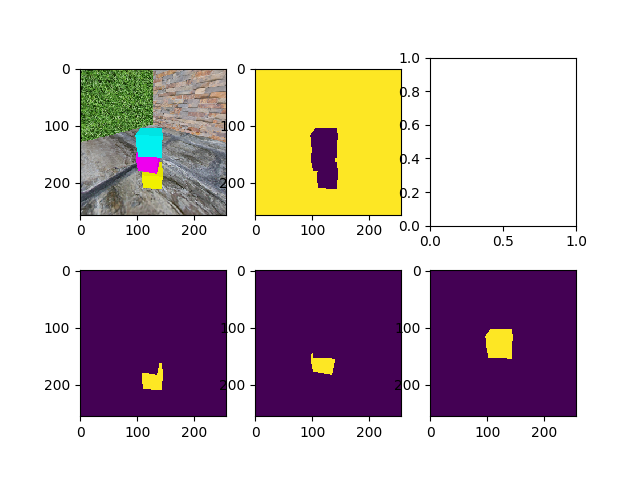Make sure you got Python 3.6+ installed. This may or may not work with older Pythons.
Git-clone this
git clone https://github.com/fgolemo/cube-stacking.git
cd into that directory
cd cube-stacking
and install away
pip install -e .
You can start a simulation, either with debugger attached (slow) or without ("headless"):
from cube_stacking.sim import CubeStacking
sim = CubeStacking(headless=False)And then you can add blocks to your heart's content:
for i in range(15):
sim.place_cube([0, 0])...where [0, 0] corresponds to the X and Y coordinate of the block and the default arena size is 8x8 (can be changed in the constructor of the CubeStacking class) and the default block size is 1x1.
To get an image, call the render function with optional segmentation map:
img, segmap = sim.render(segmap=True)To check if the block tower has fallen from the last cube:
tower_fell = sim.last_cube_fell(steps=50)...were steps=50 is the number of simulation steps that should be carried out to verify.
replace
{randomness}with eitherNonRandom,Uniform01,Uniform05, orNormal05to make cubes placement either non-random or random in a given radius{headlessness}with eitherGraphicalfor an easy way to debug the environment orHeadlessto allow for faster runtime
Environments:
Cubestacc-SinglePlayer-Heuristic-ArenaFour-{randomness}-{headlessness}-v0for a 4x4 arena in which the action space 2x[-1,1] corresponds to the [-4,4]x[-4,4] arena and placement is absolut with respect to the arenaCubestacc-SinglePlayer-Heuristic-RelativeAct-{randomness}-{headlessness}-v0for a 4x4 arena in which the action space 2x[-1,1] corresponds to the placement with respect to the reference block that is placed at the beginning of each episode
Cubestacc-TwoPlayer-Full-{randomness}-PPO-{headlessness}-v2for playing against other policies that are stored incube_stacking/self_play_policies(the algorithm will occasionally check if there are new policies in that directory) with an absolute action space 2x[-1,1]
(There are also other environments with weighted blocks, with background textures, and with other maximum-heights that I don't have time to write up right now. If you want to learn more about them, check out the code in cube_stacking/envs/ or drop a Github issue with your question.)
Use my modifies PPO:
https://github.com/fgolemo/pytorch-a2c-ppo-acktr-gail
Here's an example set of hyperparameters that works for me to train self-play policies (each policy learns to play against 20 random past policies of itself):
IMPORTANT: The current CubeStacc implementation is not thread-safe, i.e. you can NOT run multiple instances at the same time in threads. However, running multiple processes or running a single instance in multiple shells is fine.
python main.py
--custom-gym 'gibson_transfer'
--env-name 'Gibson-TwoPlayer-Full-NonRandom-PPO-Headless-v2'
--algo ppo
--use-gae
--log-interval 1
--num-steps 2048
--num-processes 1
--lr 3e-4
--entropy-coef 0
--value-loss-coef 0.5
--ppo-epoch 10
--num-mini-batch 32
--gamma 0.99
--gae-lambda 0.95
--frame-stacc 1
--num-env-steps 3000000
--use-linear-lr-decay
--save-interval 10
--seed 1234